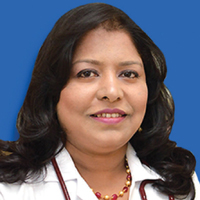Posted on Sep 29, 2019 in
FOCUS ON THE CURE

Manjula Raguthu, M.D
Medwin Family Medicine
Early detection is key in order to improve breast cancer outcome and survival. This remains the cornerstone of breast cancer control. It is a matter that must be addressed in order to educate and bring awareness to our community. Breast cancer is a form of cancer that begins in the cell of the breast and in some cases spreads to different parts of the body. The most common type of breast cancer begins in the milk duct; however, there are numerous types of breast cancer.
Early Detection
Earl signs and symptoms of breast cancer may include breast lumps, bloody discharge from the nipples, changes in the shape of breast such as dimpling, inverted nipple, peeling, scaling, flaking or redness to the breast skin. Breast cancer ranges are from 0 to IV. Stage 0 is used to describe abnormal cells that are not invasive cancer, stage IV is considered metastatic (breast cancer that has spread to the other areas of the body). For a woman who has a strong family history of breast cancer, it is highly encouraged that she performs regular self-breast exams and schedules annual exams with her local doctor in order to ensure early detection.
With the use of modern technology, there are variety of different diagnostic studies that can be performed to detect the signs of breast cancer. Remember, the earlier breast cancer is detected, the better long term health for the patient. Annual breast exams are the first non-invasive method to detect cancer by health care professionals. The first step in detecting and diagnosing breast cancer is with an x-ray, also known as a mammogram. A second study may be a breast ultrasound. Women at high risk will require an MRI as early as starting at age 30.
Treatment Options
Breast surgery is one form of treatment and may include a lumpectomy, which is the removal of the tumor and a small margin of the surrounding healthy tissue or a mastectomy, which is the removal of the entire breast. Radiation therapy uses high powered beams, such as x-rays, to kill cells.
Chemotherapy is the use of drugs to destroy cancer cells. Hormone therapy is another form of treatment and is used to treat breast cancers that are sensitive to hormones. Hormone therapy can be used after surgery to decrease the chance of cancer returning. Also, Biological therapy works with your body’s immune system to help fight cancer cells or to control side effects from the treatment.
Prevention and Outlook
There is no sure way to prevent breast cancer, but some lifestyle decisions can significantly reduce the risk of breast and other types of cancer.
These include:
- Avoiding excess alcohol consumption.
- Following a healthy diet with plenty of fresh fruits and vegetables.
- Getting enough exercise.
- Maintaining healthy body mass index (BMI).
- Women should think carefully about their options for breast feeding and use of hormone replacement therapy (HRT) following menopause, as these can affect the risk.
- Preventive surgery for women at high risk.
- Certain birth control methods can increase breast cancer risks.
With treatment, a woman who receives a diagnosis of stage 0 or stage 1 breast cancer has an almost 100 percent chance of surviving for at least five years. If the diagnosis is made at stage IV, the chance of surviving another five years is around 22 percent
Regular checks and screenings can help detect symptoms early. Women should discuss their options with a doctor.

 <
<







